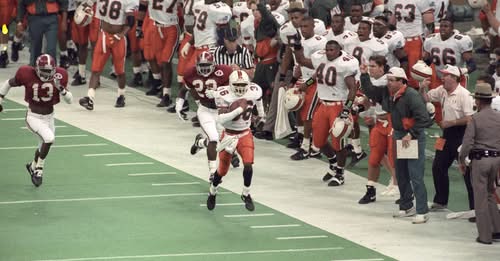The Greatest Play That Never Counted: George Teague’s Unforgettable Strip in the 1993 Sugar Bowl
In the annals of college football, there are plays that become immortalized not just because of their impact on the scoreboard, but because of the sheer brilliance, timing, and drama involved. One such play happened during the 1993 Sugar Bowl, when Alabama faced off against Miami in a clash of titans that would decide the national championship. The Crimson Tide’s George Teague made a strip of Miami’s star receiver Lamar Thomas that is often remembered as one of the greatest moments of defensive brilliance — yet it never officially counted. Despite its nullification, this play has echoed through college football history as a jaw-dropping, game-changing moment that could have altered the outcome of one of the biggest games ever played.
The context around this play is critical to understanding why it remains so legendary. Alabama and Miami were two powerhouse programs with national title aspirations on the line, making the stakes incredibly high. Miami entered the game as the defending national champions, loaded with talent and swagger, while Alabama was out to reclaim the spotlight under their seasoned coach, Gene Stallings. The stage was set for a gritty, hard-fought battle, and the nation watched eagerly as the two teams met at the Superdome in New Orleans.
Lamar Thomas was Miami’s premier receiver, known for his speed, hands, and ability to make spectacular catches in clutch moments. Throughout the game, Thomas was a primary weapon for the Hurricanes’ offense, capable of stretching the field and making big plays. On the flip side, George Teague was one of Alabama’s defensive stalwarts, an aggressive and intelligent player who could read routes and anticipate passes with precision. Their matchup was a microcosm of the entire game: speed and skill against discipline and tenacity.
The play in question occurred in the second half when Miami was attempting to rally. Thomas caught a pass and was heading upfield, looking to turn a reception into a significant gain or potentially a touchdown. Teague, showcasing incredible anticipation and reaction speed, closed the gap quickly and went for a strip — a move that requires not only timing but also fearless execution. With a swift and perfectly timed punch, Teague knocked the ball out of Thomas’s hands and managed to secure possession himself. The crowd erupted, teammates celebrated, and it appeared Alabama had just made a game-changing turnover.
But then came the controversial twist. Officials ruled that Teague was offside prior to the play, negating the turnover and forcing Alabama to give the ball back to Miami. The replay and the debate that followed have become the stuff of legend. Many felt the call was questionable, and replays suggested Teague’s timing might have been clean. Regardless, the ruling stood, and the play was wiped from the official record.
Despite the nullification, the impact of the play on the momentum and energy of the game was undeniable. Alabama’s sideline and fans were fired up, while Miami had to regroup and reset. This moment encapsulated the intensity and drama that defined the entire game. It was a reminder that even plays that don’t count on the scoreboard can change the emotional landscape of a contest.
The 1993 Sugar Bowl itself was a hard-fought, physical contest with Alabama ultimately prevailing 34-13, a decisive victory over a Miami team that many expected to dominate. Alabama’s defense was a key factor in the outcome, consistently disrupting Miami’s rhythm and limiting their explosive plays. Teague’s play, even if it was officially negated, symbolized the kind of defensive effort that helped swing the game in Alabama’s favor.
Over the years, the strip has been replayed countless times on highlight reels, in documentaries, and by fans reminiscing about great college football moments. It’s often brought up in discussions about “what could have been” and how a single call or non-call can alter the narrative of a game, and even a season. For Teague, the play solidified his reputation as a fearless defender who played with heart and smarts. For Alabama fans, it remains a treasured moment of near-magic during a championship run.
In the bigger picture, this play underscores the complexity and sometimes cruel nature of sports officiating. While technology has advanced to allow for instant replay and reviews, back then, calls were made on the fly, and human error or judgment inevitably played a role. The Teague-Thomas strip became a case study in the fine margins that separate victory from defeat and the thin line between legendary plays and missed opportunities.
The legacy of this moment also resonates with fans because it highlights the importance of defense in football. Offense often grabs the spotlight, but defensive plays like Teague’s strip remind everyone that defense can be just as thrilling and game-changing. It’s a celebration of athleticism, awareness, and the will to make a play when it matters most.
In retrospective interviews and discussions, players and coaches from both teams have acknowledged the significance of the play. Some Miami players expressed frustration over the call, feeling it could have swung momentum differently, while Alabama’s staff saw it as a spark that ignited their defense’s relentless pressure. This duality adds depth to the story, showing how one moment can mean different things to those involved.
For football historians and enthusiasts, George Teague’s strip of Lamar Thomas remains a quintessential example of a great play that, despite not appearing in the official stat sheet, is etched into the memory of the sport. It’s a reminder that sometimes the most remarkable moments are those that defy the official record but live on in the hearts and minds of fans.
In the decades since that Sugar Bowl, the game itself has evolved with rule changes, technology, and style, but the fundamental excitement of a defensive play like Teague’s strip hasn’t diminished. Whenever fans talk about memorable defensive moments, the 1993 Sugar Bowl comes up as a classic, especially that one incredible play that almost changed everything. It’s a symbol of college football’s unpredictable drama — where the line between legend and obscurity is just one call away.
Ultimately, the story of George Teague’s strip is about more than just one play. It’s about the passion and intensity of college football, the highs and lows of competition, and the way sports moments capture the imagination. It teaches us that greatness isn’t always measured by official stats or scoreboard impact, but by the lasting impression a player’s effort leaves behind.
Even if it “didn’t actually count,” Teague’s strip on Lamar Thomas will always count in the lore of college football — a moment of brilliance frozen in time, celebrated by those who understand the magic of the game.



